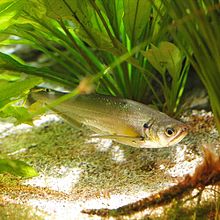Payara
| Payara | |
|---|---|

| |
| at Toba Aquarium, Japan | |
| Scientific classification | |
| Domain: | Eukaryota |
| Kingdom: | Animalia |
| Phylum: | Chordata |
| Class: | Actinopterygii |
| Order: | Characiformes |
| Family: | Cynodontidae |
| Genus: | Hydrolycus |
| Species: | H. scomberoides
|
| Binomial name | |
| Hydrolycus scomberoides | |
The payara, Hydrolycus scomberoides, is a
Amazon Basin in tropical South America.[2][3] It was the first of four species to be described in the genus Hydrolycus.[4]
Description
The most noticeable feature of H. scomberoides is the two long fangs protruding from its lower jaw. These are used to impale their prey, mostly smaller fish.
H. scomberoides is overall silvery with a dark spot behind the
pectoral fin. In adults the tail is dusky on the basal half, turning paler (more transparent) towards the tip.[4][7]
In the aquarium
The payara, which is also sold as the saber tooth barracuda, vampire fish, vampire tetra, or saber tusk barracuda, is a popular species for large, aggressive aquariums. It requires a large aquarium and can only be mixed with relatively large species, as smaller will be seen as potential prey.[3]
References
- ^ "Hydrolycus scomberoides". Integrated Taxonomic Information System. Retrieved 19 October 2017.
- ^ a b Froese, Rainer; Pauly, Daniel (eds.) (2005). "Hydrolycus scomberoides" in FishBase. 10 2005 version.
- ^ a b c d e SeriouslyFish: Hydrolycus scomberoides. Retrieved 31 October 2015.
- ^ a b c d Toledo-Piza, M.; N.A. Menezes; G.M. Santos (1999). "Revision of the Neotropical fish genus Hydrolycus (Ostariophysi: Characiformes: Cynodontidae) with the description of two new species". Ichthyol. Explor. Freshwaters. 10 (3): 255–280.
- ^ "Payara—Hydrolycus scomberoides". Acute Angling. Retrieved 19 October 2017.
- ^ Brambilla; Garcia-Ayala; Travassos; Carvalho; David (2015). "Length-weight relationships of the main commercial fish species of Tucuruí reservoir (Tocantins/Araguaia basin, Brazil)". Boletim do Instituto de Pesca. 41 (3): 665–670.
- ^ "Subfamily Cynodontinae". OPEFE. Retrieved 19 October 2017.
